Bristly Oxtongue (Helminthotheca echioides (L.) Holub) Responses to Sowing Date, Fertilization Scheme, and Chitosan Application
Abstract
:1. Introduction
2. Materials and Methods
2.1. Description Site and Biological Material
2.2. Experiment 1: Sowing Date
2.3. Experiment 2: Fertilization and Chitosan
2.4. Experiment 3: Fertilization
2.5. Measurements and Sampling in All Experiments
2.6. Statistical Analysis
3. Results
3.1. Experiment 1
3.1.1. Relative Chlorophyll Content
3.1.2. Leaf Number and Rosette Diameter
3.1.3. Fresh and Dry Biomass
3.2. Experiment 2
3.2.1. Relative Chlorophyll Content
3.2.2. Leaf Number and Rosette Diameter
3.2.3. Fresh and Dry Biomass
3.3. Experiment 3
3.3.1. Relative Chlorophyll Content
3.3.2. Root Biomass
3.3.3. Leaf Number and Rosette Diameter
3.3.4. Above-Ground Biomass and Root:Shoot Ratio
4. Discussion
5. Conclusions
Author Contributions
Funding
Institutional Review Board Statement
Informed Consent Statement
Data Availability Statement
Conflicts of Interest
References
- Voutsinos-Frantzis, O.; Ntatsi, G.; Karavidas, I.; Neofytou, I.; Deriziotis, K.; Ropokis, A.; Consentino, B.B.; Sabatino, L.; Savvas, D. Exploring the Simultaneous Effect of Total Ion Concentration and K:Ca:Mg Ratio of the Nutrient Solution on the Growth and Nutritional Value of Hydroponically Grown Cichorium spinosum L. Agronomy 2022, 12, 2214. [Google Scholar] [CrossRef]
- Karkanis, A.C.; Petropoulos, S.A. Physiological and Growth Responses of Several Genotypes of Common Purslane (Portulaca oleracea L.) under Mediterranean Semi-arid Conditions. Not. Bot. Horti Agrobot. 2017, 45, 569–575. [Google Scholar] [CrossRef] [Green Version]
- Liava, V.; Karkanis, A.; Tsiropoulos, N. Yield and Silymarin Content in Milk Thistle (Silybum marianum (L.) Gaertn.) Fruits Affected by the Nitrogen Fertilizers. Ind. Crops Prod. 2021, 171, 113955. [Google Scholar] [CrossRef]
- Arampatzis, D.A.; Karkanis, A.C.; Tsiropoulos, N.G. Silymarin Content and Antioxidant Activity of Seeds of Wild Silybum marianum Populations Growing in Greece. Ann. Appl. Biol. 2019, 174, 61–73. [Google Scholar] [CrossRef] [Green Version]
- Zahra, N.; Wahid, A.; Hafeez, M.B.; Alyemeni, M.N.; Shah, T.; Ahmad, P. Plant Growth Promoters Mediated Quality and Yield Attributes of Milk Thistle (Silybum marianum L.) Ecotypes under Salinity stress. Sci. Rep. 2021, 11, 23200. [Google Scholar] [CrossRef]
- Marceddu, R.; Dinolfo, L.; Carrubba, A.; Sarno, M.; Di Miceli, G. Milk Thistle (Silybum Marianum L.) as a Novel Multipurpose Crop for Agriculture in Marginal Environments: A Review. Agronomy 2022, 12, 729. [Google Scholar] [CrossRef]
- Nemzer, B.; Al-Taher, F.; Abshiru, N. Phytochemical Composition and Nutritional Value of Different Plant Parts in two Cultivated and Wild Purslane (Portulaca oleracea L.) Genotypes. Food Chem. 2020, 320, 126621. [Google Scholar] [CrossRef]
- Mallor, C.; Carravedo, M.; Montaner, C. Field Collection and Conservation of Non-Cultivated Edible Species in the Germplasm Bank of Zaragoza (SPAIN). Acta Hortic. 2011, 918, 59–64. [Google Scholar] [CrossRef]
- Alexopoulos, A.A.; Assimakopoulou, A.; Panagopoulos, P.; Bakea, M.; Vidalis, N.; Karapanos, I.C.; Petropoulos, S.A. Impact of Salinity on the Growth and Chemical Composition of Two Underutilized Wild Edible Greens: Taraxacum officinale and Reichardia picroides. Horticulturae 2021, 7, 160. [Google Scholar] [CrossRef]
- Freitas, J.A.; Ccana-Ccapatinta, G.V.; Da Costa, F.B. LC-MS Metabolic Profiling Comparison of Domesticated Crops and Wild Edible Species from the Family Asteraceae Growing in a Region of São Paulo State, Brazil. Phytochem. Lett. 2021, 42, 45–51. [Google Scholar] [CrossRef]
- Andersen, M.C. An Analysis of Variability in Seed Settling Velocities of Several Wind-Dispersed Asteraceae. Am. J. Bot. 1992, 79, 1087–1091. [Google Scholar] [CrossRef] [PubMed]
- Ronel, M.; Khateeb, S.; Lev-Yadun, S. Protective Spiny Modules in Thistles of the Asteraceae in Israel. J. Torrey Bot. Soc. 2009, 136, 46–56. [Google Scholar] [CrossRef]
- Al-Balawi, S.M.; Alwahibi, M.S.; Al-Harbi, N.A. Diversity and Floristic Study of Weeds Species in Tabuk Region Farms in Saudi Arabia. Int. J. Bot. Stud. 2021, 6, 1560–1566. [Google Scholar]
- Vurro, M.; Townley, H.E.; Morrison, R.; Boari, A.; Masi, M.; Evidente, A. Augmented Phytotoxic Effect of Nanoencapsulated Ophiobolin A. Nat. Prod. Res. 2022, 36, 1143–1150. [Google Scholar] [CrossRef]
- Pieroni, A.; Sulaiman, N.; Sõukand, R. Chorta (Wild Greens) in Central Crete: The Bio-Cultural Heritage of a Hidden and Resilient Ingredient of the Mediterranean Diet. Biology 2022, 11, 673. [Google Scholar] [CrossRef]
- Petropoulos, S.A.; Fernandes, Â.; Tzortzakis, N.; Sokovic, M.; Ciric, A.; Barros, L.; Ferreira, I.C.F.R. Bioactive Compounds Content and Antimicrobial Activities of Wild Edible Asteraceae Species of the Mediterranean Flora under Commercial Cultivation Conditions. Food Res. Int. 2019, 119, 859–868. [Google Scholar] [CrossRef] [Green Version]
- Sergio, L.; Boari, F.; Pieralice, M.; Linsalata, V.; Cantore, V.; Di Venere, D. Bioactive Phenolics and Antioxidant Capacity of Some Wild Edible Greens as Affected by Different Cooking Treatments. Foods 2020, 9, 1320. [Google Scholar] [CrossRef]
- Savo, V.; Salomone, F.; Mattoni, E.; Tofani, D.; Caneva, G. Traditional Salads and Soups with Wild Plants as a Source of Antioxidants: A Comparative Chemical Analysis of Five Species Growing in Central Italy. Evid. Based Complement. Altern. Med. 2019, 2019, 6782472. [Google Scholar] [CrossRef] [Green Version]
- Guillemin, J.P.; Gardarin, A.; Granger, S.; Reibel, C.; Munier-Jolain, N.; Colbach, N. Assessing Potential Germination Period of Weeds with Base Temperatures and Base Water Potentials. Weed Res. 2013, 53, 76–87. [Google Scholar] [CrossRef]
- Petropoulos, S.; Fernandes, A.; Karkanis, A.; Antoniadis, V.; Barros, L.; Ferreira, I.C.F.R. Nutrient Solution Composition and Growing Season Affect Yield and Chemical Composition of Cichorium spinosum plants. Sci. Hortic. 2018, 231, 97–107. [Google Scholar] [CrossRef] [Green Version]
- Chen, C.-C.; Huang, M.-Y.; Lin, K.-H.; Hsueh, M.-T. The Effects of Nitrogen Application on the Growth, Photosynthesis, and Antioxidant Activity of Amaranthus viridis. Photosynthetica 2022, 60, 420–429. [Google Scholar] [CrossRef]
- Pichyangkura, R.; Chadchawan, S. Biostimulant Activity of Chitosan in Horticulture. Sci. Hortic. 2015, 196, 49–65. [Google Scholar] [CrossRef]
- Mukhtar Ahmed, K.B.; Khan, M.M.A.; Siddiqui, H.; Jahan, A. Chitosan and its Oligosaccharides, a Promising Option for Sustainable Crop Production—A Review. Carbohydr. Polym. 2020, 227, 115331. [Google Scholar] [CrossRef] [PubMed]
- Sible, C.N.; Seebauer, J.R.; Below, F.E. Plant Biostimulants: A Categorical Review, Their Implications for Row Crop Production, and Relation to Soil Health Indicators. Agronomy 2021, 11, 1297. [Google Scholar] [CrossRef]
- Deolu-Ajayi, A.O.; van der Meer, I.M.; van der Werf, A.; Karlova, R. The Power of Seaweeds as Plant Biostimulants to Boost Crop Production under Abiotic Stress. Plant Cell Environ. 2022, 45, 2537–2553. [Google Scholar] [CrossRef]
- Salachna, P.; Łopusiewicz, Ł. Chitosan Oligosaccharide Lactate Increases Productivity and Quality of Baby Leaf Red Perilla. Agronomy 2022, 12, 1182. [Google Scholar] [CrossRef]
- Shahrajabian, M.H.; Cheng, Q.; Sun, W. The Effects of Amino Acids, Phenols and Protein Hydrolysates as Biostimulants on Sustainable Crop Production and Alleviated Stress. Recent Pat. Biotechnol. 2022, 16, 319–328. [Google Scholar]
- Stasińska-Jakubas, M.; Hawrylak-Nowak, B. Protective, Biostimulating, and Eliciting Effects of Chitosan and Its Derivatives on Crop Plants. Molecules 2022, 27, 2801. [Google Scholar] [CrossRef]
- Fouda, S.E.E.; El-Saadony, F.M.A.; Saad, A.M.; Sayed, S.M.; El-Sharnouby, M.; El-Tahan, A.M.; El-Saadony, M.T. Improving Growth and Productivity of Faba Bean (Vicia faba L.) Using Chitosan, Tryptophan, and Potassium Silicate Anti-Transpirants under Different Irrigation Regimes. Saudi J. Biol. Sci. 2022, 29, 955–962. [Google Scholar] [CrossRef]
- Zhang, G.; Wang, Y.; Wu, K.; Zhang, Q.; Feng, Y.; Miao, Y.; Yan, Z. Exogenous Application of Chitosan Alleviate Salinity Stress in Lettuce (Lactuca sativa L.). Horticulturae 2021, 7, 342. [Google Scholar] [CrossRef]
- Khodadadi, F.; Ahmadi, F.S.; Talebi, M.; Moshtaghic, N.; Matkowski, A.; Szumny, A.; Rahimmalek, M. Essential Oil Composition, Physiological and Morphological Variation in Salvia abrotanoides and S. yangii under Drought Stress and Chitosan Treatments. Ind. Crops Prod. 2022, 187, 115429. [Google Scholar] [CrossRef]
- Wang, Q.; Zuo, J.-H.; Wang, Q.; Na, Y.; Gao, L.-P. Inhibitory Effect of Chitosan on Growth of the Fungal Phytopathogen, Sclerotinia sclerotiorum, and Sclerotinia Rot of Carrot. J. Integr. Agric. 2015, 14, 691–697. [Google Scholar] [CrossRef]
- Rendina, N.; Nuzzaci, M.; Scopa, A.; Cuypers, A.; Sofo, A. Chitosan-Elicited Defense Responses in Cucumber Mosaic Virus (CMV)-Infected Tomato Plants. J. Plant Physiol. 2019, 234–235, 9–17. [Google Scholar] [CrossRef] [PubMed]
- Mustafa, M.A.; Mayes, S.; Massawe, F. Crop diversification through a wider use of underutilised crops: A strategy to ensure food and nutrition security in the face of climate change. In Sustainable Solutions for Food Security; Sarkar, A., Sensarma, S., vanLoon, G., Eds.; Springer: Cham, Switzerland, 2019; pp. 125–149. [Google Scholar]
- Zhao, J.; Bindi, M.; Eitzinger, J.; Ferrise, R.; Gaile, Z.; Gobin, A.; Holzkämper, A.; Kersebaum, K.-C.; Kozyra, J.; Kriaučiūnienė, Z.; et al. Priority for Climate Adaptation Measures in European Crop Production Systems. Eur. J. Agron. 2022, 138, 126516. [Google Scholar] [CrossRef]
- Geremew, A.; Carson, L.; Woldesenbet, S.; Carpenter, C.; Peace, E.; Weerasooriya, A. Interactive Effects of Organic Fertilizers and Drought Stress on Growth and Nutrient Content of Brassica juncea at Vegetative Stage. Sustainability 2021, 13, 13948. [Google Scholar] [CrossRef]
- Xu, C.; Mou, B. Chitosan as Soil Amendment Affects Lettuce Growth, Photochemical Efficiency, and Gas Exchange. HortTechnology 2018, 28, 476–480. [Google Scholar] [CrossRef] [Green Version]
- Collins, M.; McCoy, J.E. Chicory Productivity, Forage Quality, and Response to Nitrogen Fertilization. Agron. J. 1997, 89, 232–238. [Google Scholar] [CrossRef]
- Sylvestre, T.D.B.; Braos, L.B.; Batistella Filho, F.; Cruz, M.C.P.D.; Ferreira, M.E. Mineral Nitrogen Fertilization Effects on Lettuce Crop Yield and Nitrogen Leaching. Sci. Hortic. 2019, 255, 153–160. [Google Scholar] [CrossRef]
- Semenov, M.A.; Jamieson, P.D.; Martre, P. Deconvoluting Nitrogen Use Efficiency in Wheat: A Simulation Study. Eur. J. Agron. 2007, 26, 283–294. [Google Scholar] [CrossRef]
- Woli, P.; Hoogenboom, G.; Alva, A. Simulation of Potato Yield, Nitrate Leaching, and Profit Margins as Influenced by Irrigation and Nitrogen Management in Different Soils and Production Regions. Agric. Water Manag. 2016, 171, 120–130. [Google Scholar] [CrossRef] [Green Version]
- Ren, K.; Xu, M.; Li, R.; Zheng, L.; Liu, S.; Reis, S.; Wang, H.; Lu, C.; Zhang, W.; Gao, H.; et al. Optimizing Nitrogen Fertilizer Use for More Grain and Less Pollution. J. Clean. Prod. 2022, 360, 132180. [Google Scholar] [CrossRef]
- Chatzigianni, M.; Alkhaled, B.; Livieratos, I.; Stamatakis, A.; Ntatsi, G.; Savvas, D. Impact of Nitrogen Source and Supply Level on Growth, Yield and Nutritional Value of two Contrasting Ecotypes of Cichorium spinosum L. Grown Hydroponically. J. Sci. Food Agric. 2018, 98, 1615–1624. [Google Scholar] [CrossRef] [PubMed]
- Chatzigianni, M.; Ntatsi, G.; Theodorou, M.; Stamatakis, A.; Livieratos, I.; Rouphael, Y.; Savvas, D. Functional Quality, Mineral Composition and Biomass Production in Hydroponic Spiny Chicory (Cichorium spinosum L.) are Modulated Interactively by Ecotype, Salinity and Nitrogen Supply. Front. Plant Sci. 2019, 10, 1040. [Google Scholar] [CrossRef] [PubMed] [Green Version]
- Guarise, M.; Borgonovo, G.; Bassoli, A.; Ferrante, A. Effect of Fertilization on Yield and Quality of Sisymbrium officinale (L.) Scop. Grown as Leafy Vegetable Crop. Agronomy 2019, 9, 401. [Google Scholar] [CrossRef] [Green Version]
- Blandino, M.; Battisti, M.; Vanara, F.; Reyneri, A. The Synergistic Effect of Nitrogen and Phosphorus Starter Fertilization Sub-surface Banded at Sowing on the Early Vigor, Grain Yield and Quality of Maize. Eur. J. Agron. 2022, 137, 126509. [Google Scholar] [CrossRef]
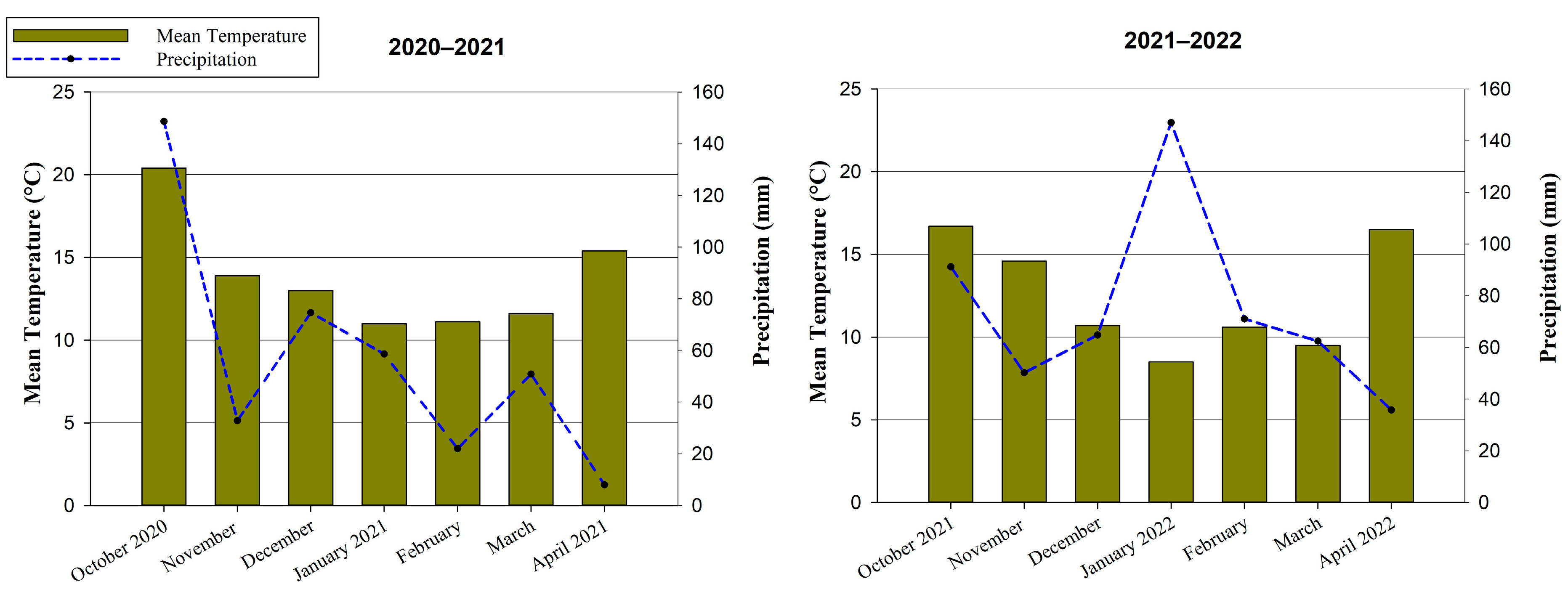
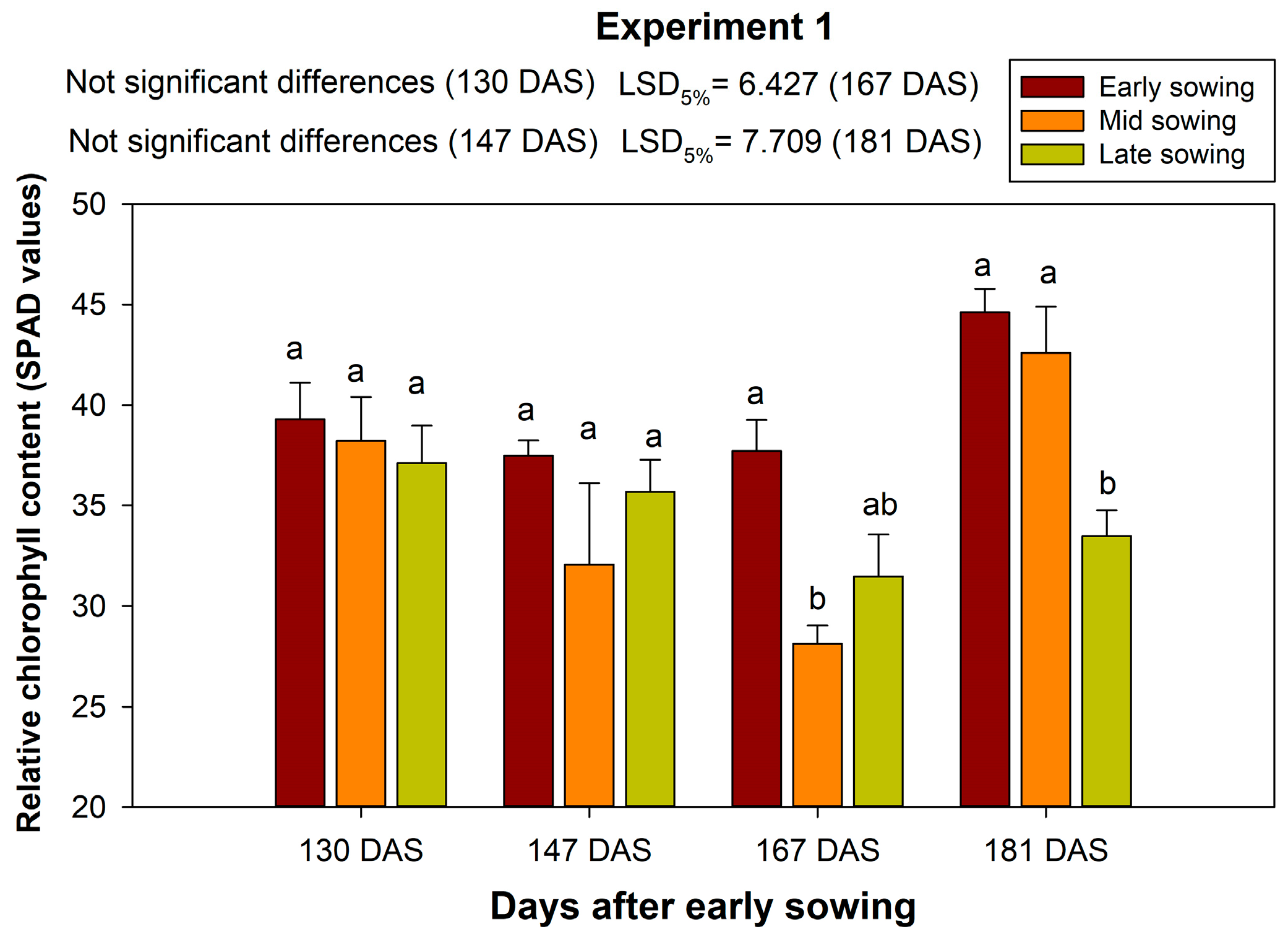
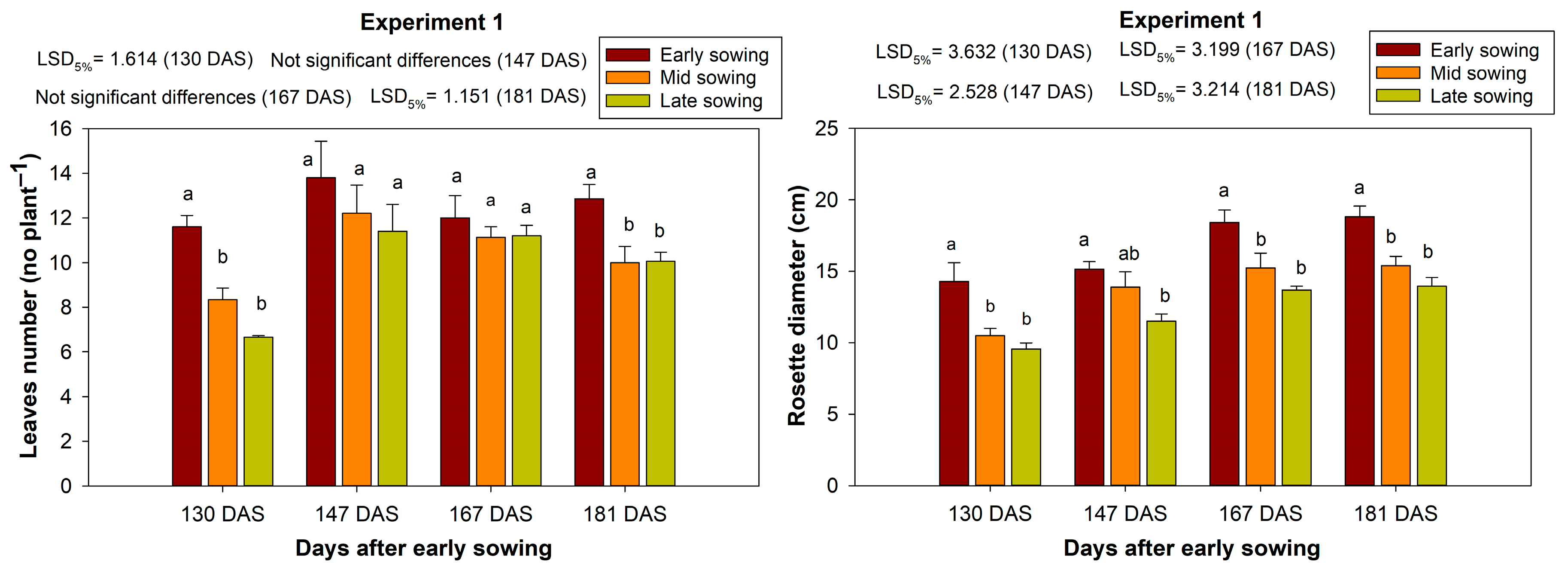
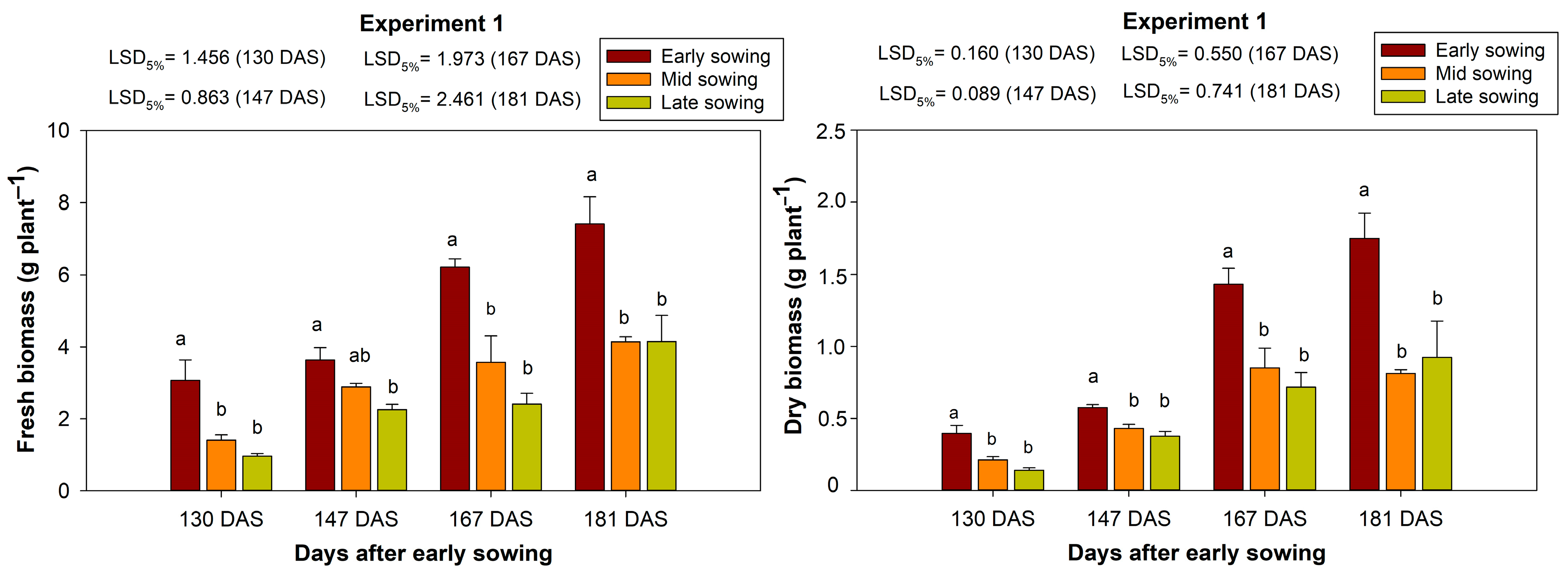
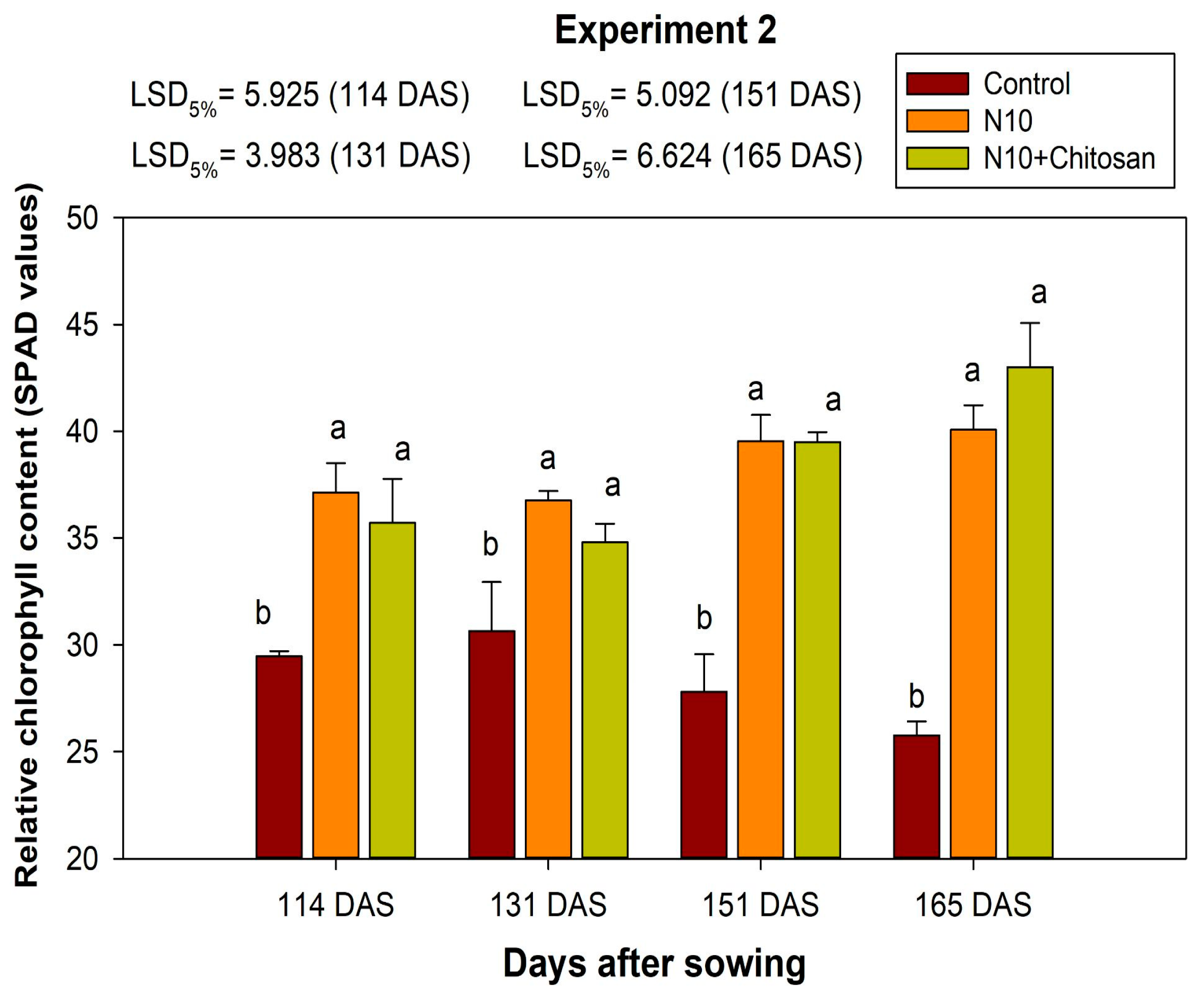

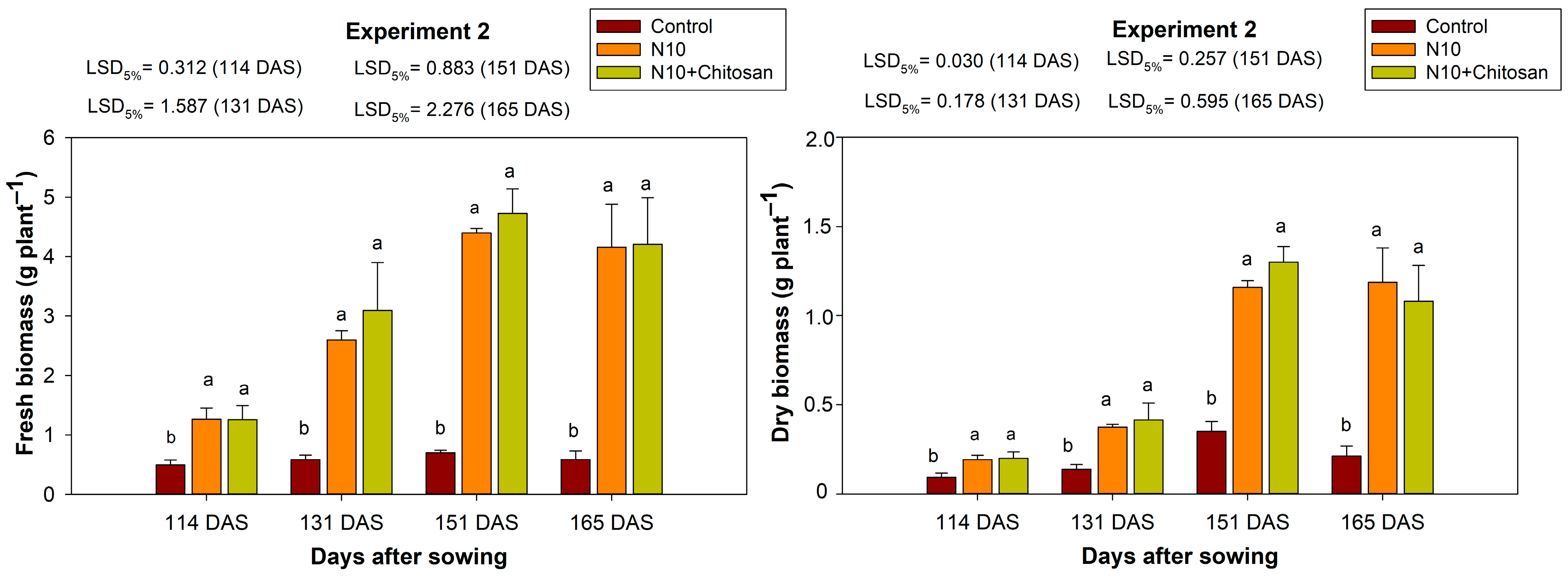

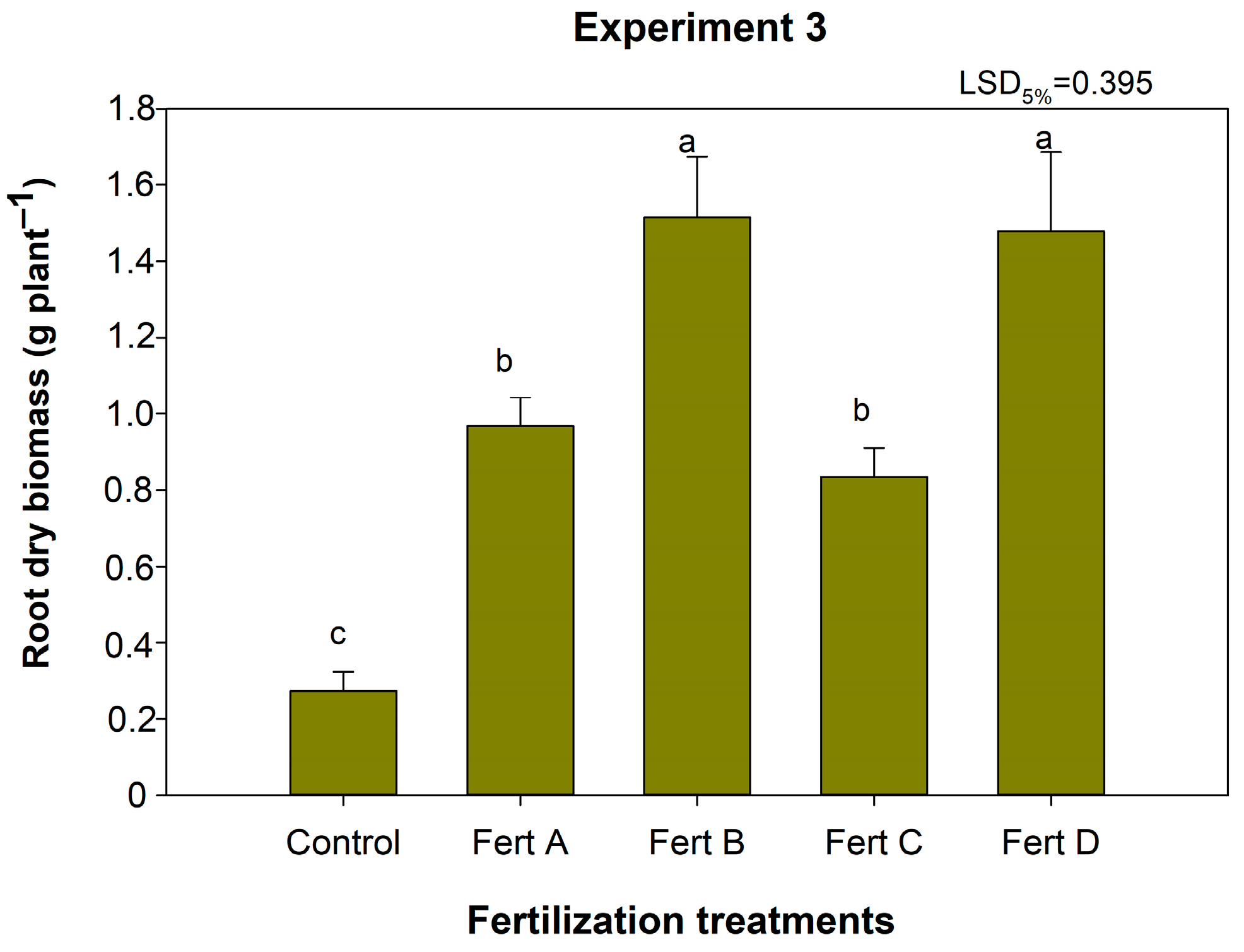

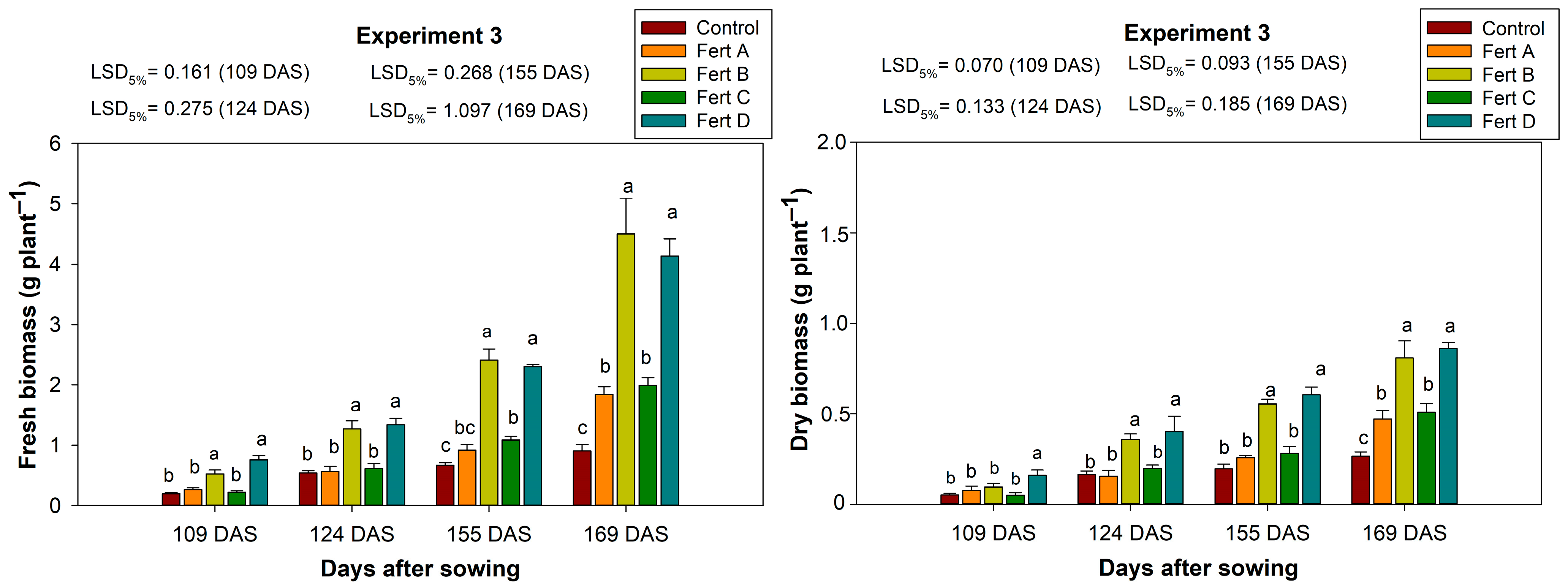
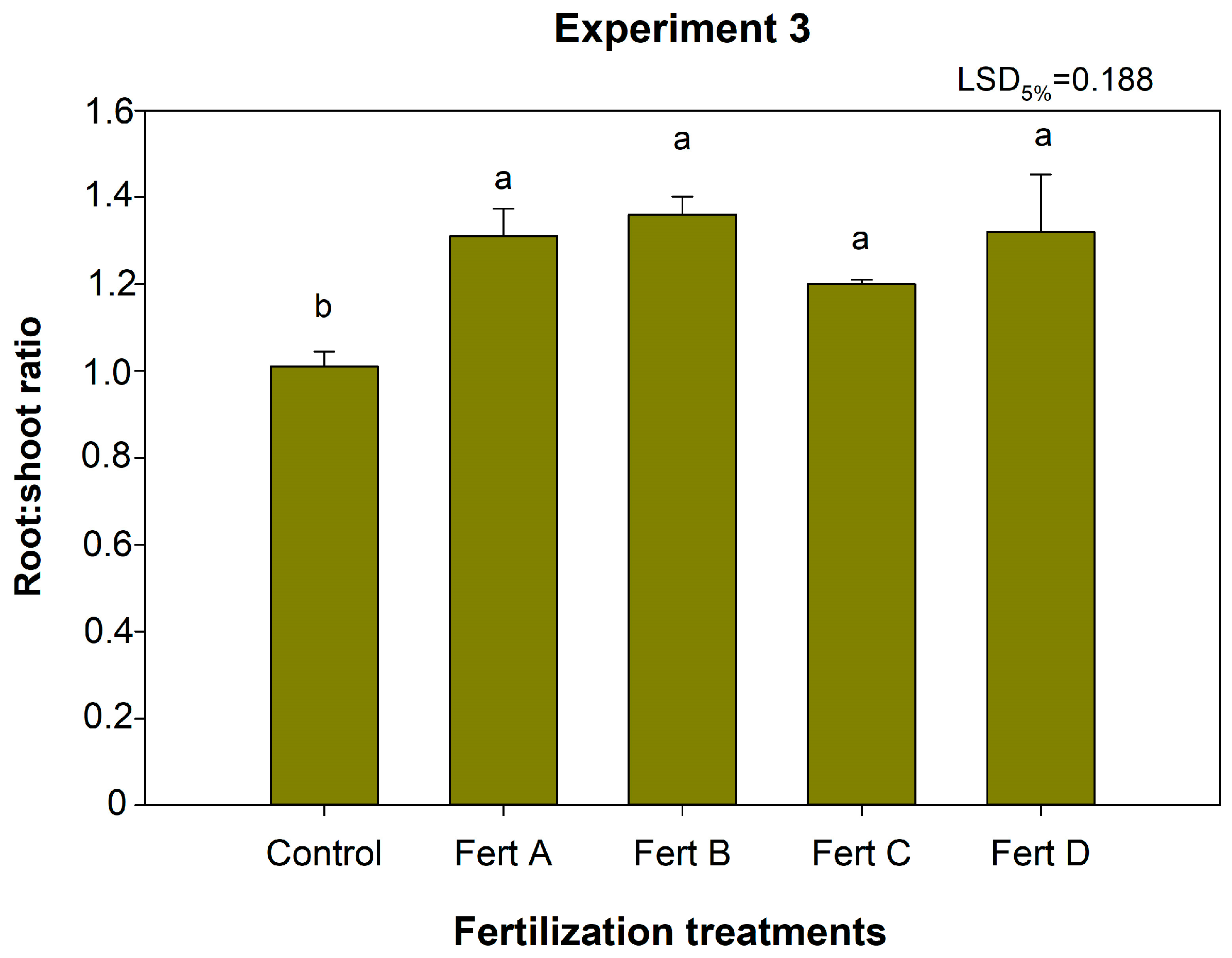
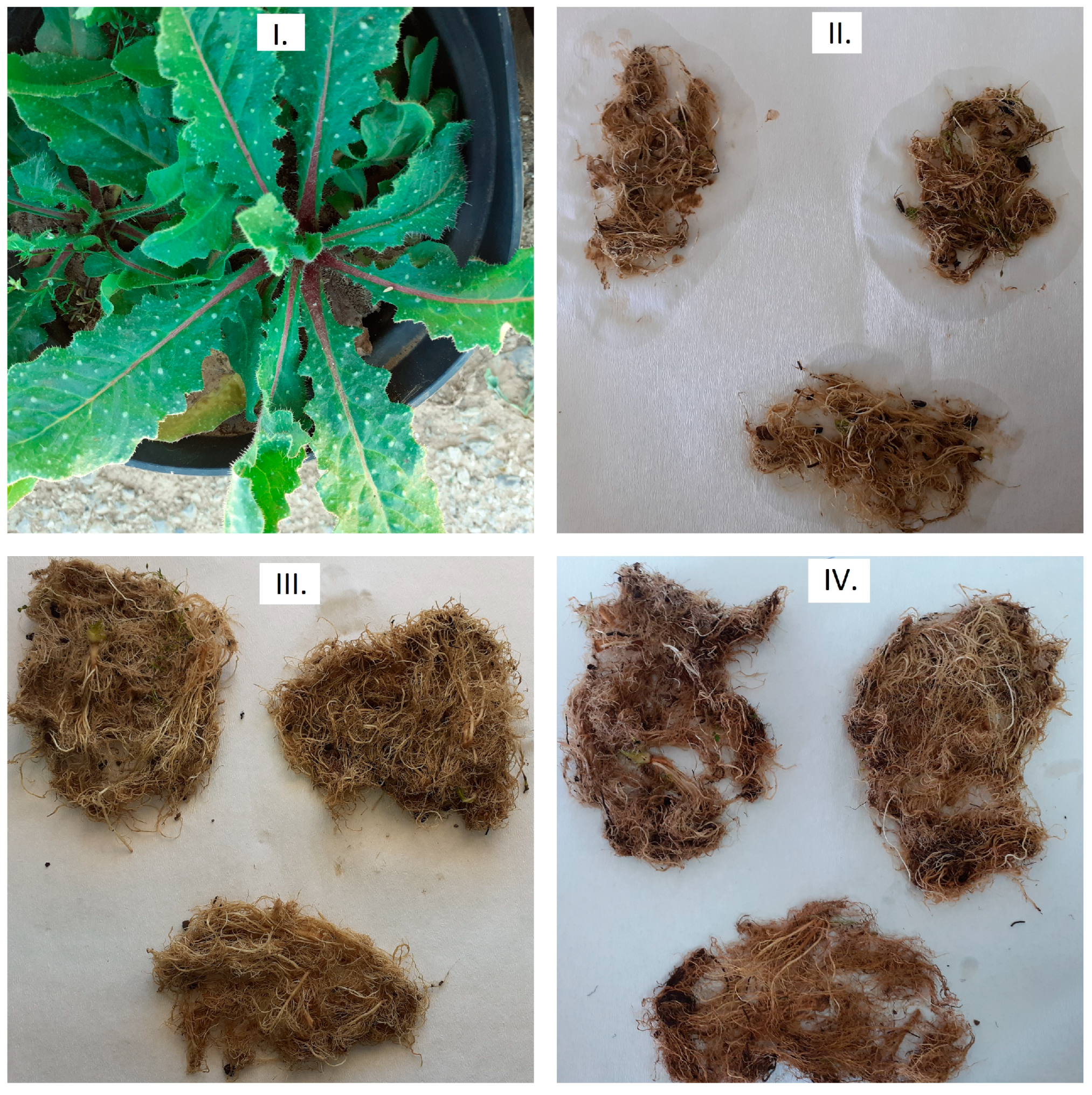
| Treatments | Nitrogen Fertilization 1 | Chitosan Hydrochloride 2 |
|---|---|---|
| Control | 0 kg ha−1 | No |
| N10 | 100 kg ha−1 | No |
| N10 + chitosan | 100 kg ha−1 | Yes |
| Treatments | Basal Fertilization (15-5-20 (+2+8); N-P2O5-K2O (MgO + S) 1 | Top Dressing Fertilization 2 |
|---|---|---|
| Control | 0 kg ha−1 | 0 kg N ha−1 |
| Fert A | 250 kg ha−1 | 50 kg N ha−1 |
| Fert B | 250 kg ha−1 | 100 kg N ha−1 |
| Fert C | 500 kg ha−1 | 50 kg N ha−1 |
| Fert D | 500 kg ha−1 | 100 kg N ha−1 |
Publisher’s Note: MDPI stays neutral with regard to jurisdictional claims in published maps and institutional affiliations. |
© 2022 by the authors. Licensee MDPI, Basel, Switzerland. This article is an open access article distributed under the terms and conditions of the Creative Commons Attribution (CC BY) license (https://creativecommons.org/licenses/by/4.0/).
Share and Cite
Karkanis, A.; Tsoutsoura, G.; Ntanovasili, E.; Mavroviti, V.; Ntatsi, G. Bristly Oxtongue (Helminthotheca echioides (L.) Holub) Responses to Sowing Date, Fertilization Scheme, and Chitosan Application. Agronomy 2022, 12, 3028. https://doi.org/10.3390/agronomy12123028
Karkanis A, Tsoutsoura G, Ntanovasili E, Mavroviti V, Ntatsi G. Bristly Oxtongue (Helminthotheca echioides (L.) Holub) Responses to Sowing Date, Fertilization Scheme, and Chitosan Application. Agronomy. 2022; 12(12):3028. https://doi.org/10.3390/agronomy12123028
Chicago/Turabian StyleKarkanis, Anestis, Georgia Tsoutsoura, Evangelia Ntanovasili, Vasiliki Mavroviti, and Georgia Ntatsi. 2022. "Bristly Oxtongue (Helminthotheca echioides (L.) Holub) Responses to Sowing Date, Fertilization Scheme, and Chitosan Application" Agronomy 12, no. 12: 3028. https://doi.org/10.3390/agronomy12123028
APA StyleKarkanis, A., Tsoutsoura, G., Ntanovasili, E., Mavroviti, V., & Ntatsi, G. (2022). Bristly Oxtongue (Helminthotheca echioides (L.) Holub) Responses to Sowing Date, Fertilization Scheme, and Chitosan Application. Agronomy, 12(12), 3028. https://doi.org/10.3390/agronomy12123028








